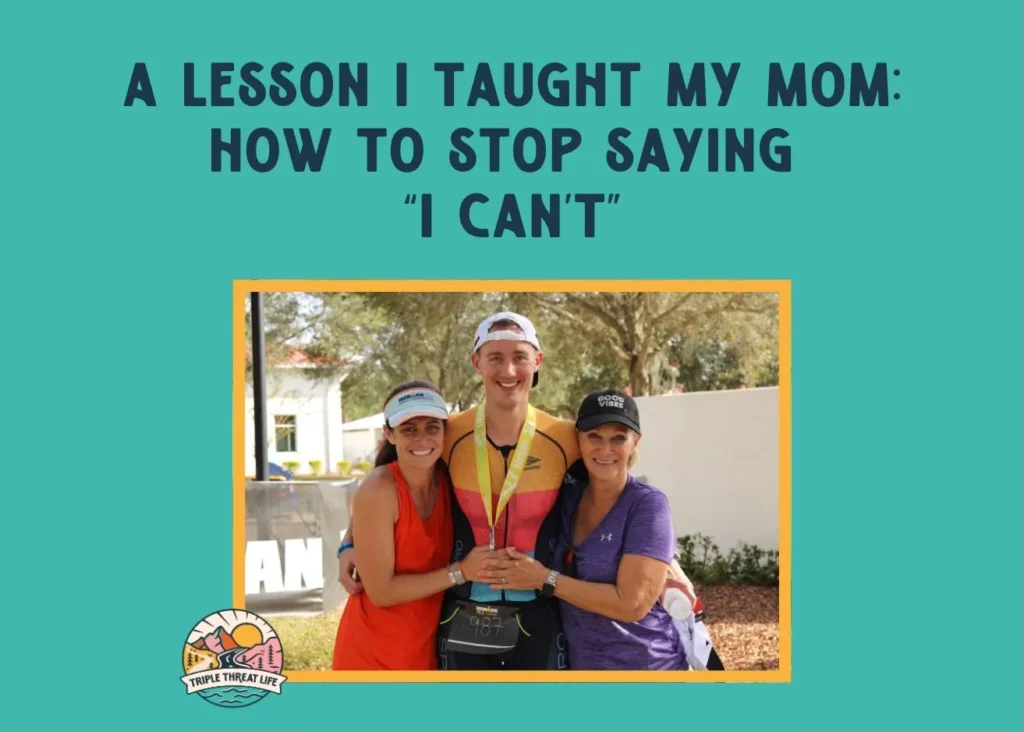
Last night, Matt and I made salmon burgers and quinoa salad for dinner.
Our plan was to watch the latest edition of Hard Knocks: Training Camp with the Chicago Bears, so we invited Mom over to eat her least favorite food (fish) and find out if Caleb Williams is worth all the hype.
As we munched on golden, crusty, lemon dill salmon burgers topped with pickled onions and dijon mustard, Mom shared some exciting news. She’s testing to move up to level 2 in her pilates class on Friday.
Now, Matt and I are triathletes. We swim, bike, and run. But pilates? Honestly, have no idea what goes on those classes. If my assumption is correct, there’s a lot of planking and body weight exercises that trim and tone. It certainly sounds challenging, but I’ve never done it myself.
Nevertheless, it’s Mom’s current obsession. And we’re thrilled about it.
She goes six days a week, sometimes twice a day, which is quite a change from a year ago when her only exercise was working in the garden.
Last week, she said she would be late for dinner because she signed up for a 6:30 pm class… I thought, who are you and what have you done with my mother?
Now about this pilates test coming up on Friday. She’s worried because there’s one skill she has yet to master- a straight-leg sit-up.
Basically, you lie flat on your back with your legs extended. Then, you engage your core and lift your upper body up into a sitting position. It’s a bit more challenging than a typical “crunch” because your legs are outstretched.
She was frustrated because she can “do all the other exercises longer than other people in the class,” but the straight-leg sit-up has eluded her.
Until now…
She explained how two different instructors tried to help her do the exercise, but to no avail. At this point, you can understand why she thinks it’s something she can’t do.
But I had a feeling that the problem wasn’t with her body. It was in her head.
So we came up with a plan.
First, we had her demonstrate what she was trying to do. Then, Matt and I did the exercise ourselves so we could determine how to do it.
Next, I asked her (a few times) to stop saying “I can’t.” I received some significant motherly side-eye at this request.
Now I don’t know everything. But if there’s one thing I do know, it’s figuring out how to overcome mental hurdles. That begins with removing this limiting phrase from your vocabulary.
“Whether you think you can, or you think you can’t—you’re right.” – Henry Ford
Why we say “I can’t”
Think about the last time you used this phrase.
“I can’t do a triathlon. I don’t have the time to train.”
“I can’t start my own business. I have bills to pay and a family to support.”
“I can’t fix my relationship issues. I have emotional baggage.”
Look at the pattern. First, we use “can’t” as the limiter and then we provide a reason/excuse why our assessment is true. (“I can’t” + this is why I can’t.)
But what are you really saying?
“I can’t do a triathlon, because I don’t want to carve out the time to train.”
“I can’t start my own business, because I’m afraid I will fail.”
“I can’t fix my relationship issues, because I’m scared I will get hurt again.”
There are many reasons why we say “I can’t.” Sometimes, it’s a lack of confidence, the fear of failure, or because we don’t want to venture outside our comfort zone. It can be a result of past experiences, perceived difficulty, or a lack of knowledge and resources.
Most often it’s due to a cognitive distortion. We believe we can’t do something and therefore we can’t.
The thing is whatever you believe about yourself, whether it’s good or bad, you’re right. The power of belief in determining your success or failure cannot be understated.
5 Step Process to turn “Can’t” into “Can”
One thing you “can’t” do is move forward without a plan, so here are five steps to take to turn “I can’t” into “I can.”
- Identity the underlying belief- First, determine why you think you can’t do something. Is it fear of failure? Lack of confidence? Because you’re scared? Uncovering the root problem will help you address it directly.
- Determine what you need to do to turn “can’t” into “can.”– Figure out the steps you need to take in order to accomplish your goal. Then, come up with a clear plan of action.
- Set small achievable goals- Break the larger goal into smaller steps and practice implementing daily. Achieving smaller goals helps to build confidence.
- Challenge negative thoughts- If you catch yourself saying “I can’t,” think about whether that’s really true. Reframe your concerns to be more positive- “I haven’t done it yet, but I’m going to work as hard as I can until I get it right.”
- Get support and feedback- Talk to a friend, coach, or family member to maintain accountability and gain an outside perspective. Maybe there’s something you’ve overlooked.
Here’s what this process looked like for Mom’s pilates challenge.
Remember, she needs to do a straight-leg sit-up. She’s tried many times and hasn’t been able to do it yet. She’s asked for advice and nobody has been able to help her achieve her goal.
I think she says she “can’t” because she hasn’t been able to yet. But that’s completely different. This is probably a result of past experiences and a lack of confidence. (underlying belief)
So we watched her attempt the sit-up and then did the exercise ourselves. We determined which muscles she would need to activate in order to do it successfully. (determine how to turn can’t into can.)
Next, we analyzed her form and came up with a few cue words she could use. She needed to cough to engage her low abdominal muscles, use her arms overhead for propulsion, count to three, and hinge at the hip to sit up. Then, she practiced. (small goals)
She wasn’t allowed to say “I can’t,” but only focus on what she needed to do to make it happen. (challenge negative thoughts)
We kept watching, encouraging, and made a few modifications. (support and feedback)
So what happened?
She went home. 15 minutes later we got this text.

So join us in wishing Mom good luck on her level 2 pilates test this Friday. I have a feeling she’s going to be just fine as long as she focuses on “can” instead of “can’t.”
Also, now we’re going to see if she actually reads my blog posts, or just likes the photos on Instagram. 😉
Oh, here’s the recipe for the lemon-dill salmon burgers. They’re awesome.
- 1 egg beaten
- 1 (14. oz) can salmon, drained
- 2/3 cup panko bread crumbs
- 1 clove finely chopped garlic
- zest of 1 lemon
- 2 Tbsp. lemon juice
- 2 Tbsp. fresh dill
- 1 Tbsp. Dijon mustard
- 1 tsp. Worcestershire sauce
- salt and pepper
Combine mixture in a large bowl and make 4 patties. In a large skillet, cook in olive oil over medium heat. Cook until browned on each side- 5 minutes. Put patties on hamburger buns with mayo, mustard, pickled onions, and lettuce. Enjoy!
(adapted from Delish)


